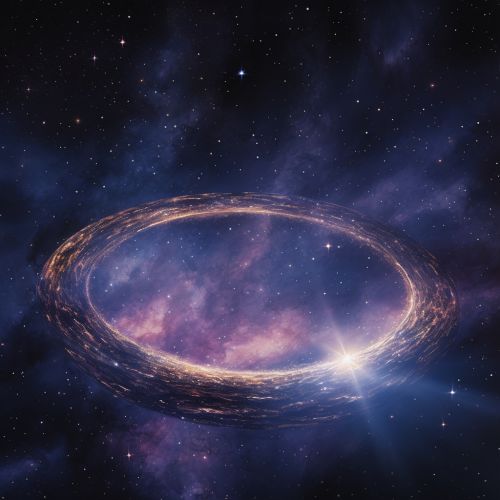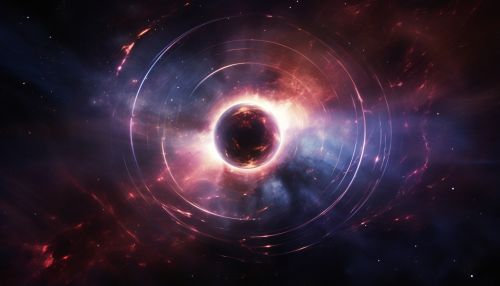Gravitational lensing
Introduction
Gravitational lensing is a phenomenon that is directly related to the principles of general relativity. It occurs when a massive object, such as a galaxy or a black hole, bends the path of light that passes near it. This bending of light results in a magnification and distortion of the image of an object that is behind the massive object from the viewpoint of an observer.
Theory
The theoretical foundation of gravitational lensing was first proposed by Albert Einstein in 1915 as a part of his general theory of relativity. According to the theory, mass and energy cause a curvature of spacetime, and light follows the curvature of spacetime, which results in the bending of the path of light in the presence of a massive object.
Einstein's Field Equations
The phenomenon of gravitational lensing is a direct consequence of Einstein's field equations, which are a set of ten interrelated differential equations that describe the fundamental interaction of gravitation as a result of spacetime being curved by mass and energy. The field equations are complex and require a high level of mathematical understanding to solve.
Light Deflection
The deflection of light by gravity can be understood by considering a beam of light as a stream of particles (photons) that are deflected by a gravitational field. The path of a photon is determined by the geometry of spacetime, which is influenced by the distribution of mass and energy. The deflection angle, which is the angle by which the path of light is bent, is directly proportional to the gravitational field strength.
Observations
Gravitational lensing is observed in many astrophysical contexts. It is used as a tool to study galaxies and clusters of galaxies, and it provides a way to measure the distribution of dark matter. It also allows the study of the universe on the largest scales.
Galaxy Clusters
Galaxy clusters are the largest gravitationally bound structures in the universe, and they are often associated with strong gravitational lensing effects. The distribution of dark matter in galaxy clusters can be studied by analyzing the distortions of the images of galaxies that are behind the cluster from the viewpoint of an observer.
Quasars
Quasars are extremely luminous active galactic nuclei, and they are often observed to be gravitationally lensed. Multiple images of the same quasar can be observed as a result of gravitational lensing, and the differences in the arrival times of the light from the different images can be used to estimate the Hubble constant.
Applications
Gravitational lensing has many applications in astrophysics and cosmology. It is used to measure the masses of galaxies and galaxy clusters, to study the distribution of dark matter, and to measure the Hubble constant. It is also used to detect exoplanets and to study the early universe.
Dark Matter
Gravitational lensing is one of the main tools used to study the distribution of dark matter in the universe. Dark matter does not emit or absorb light, but it has mass, and therefore it can cause gravitational lensing. The distortions of the images of galaxies that are caused by gravitational lensing can be used to map the distribution of dark matter.
Exoplanets
Gravitational microlensing is used to detect exoplanets. When a star that is in the foreground from the viewpoint of an observer (the lens) passes exactly in front of a star that is in the background (the source), the light from the source is magnified by the gravitational field of the lens. If the lens has a planet, the light curve of the source shows a characteristic anomaly that can be used to detect the planet.


